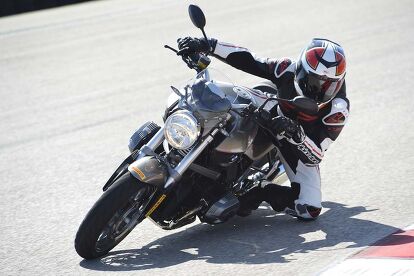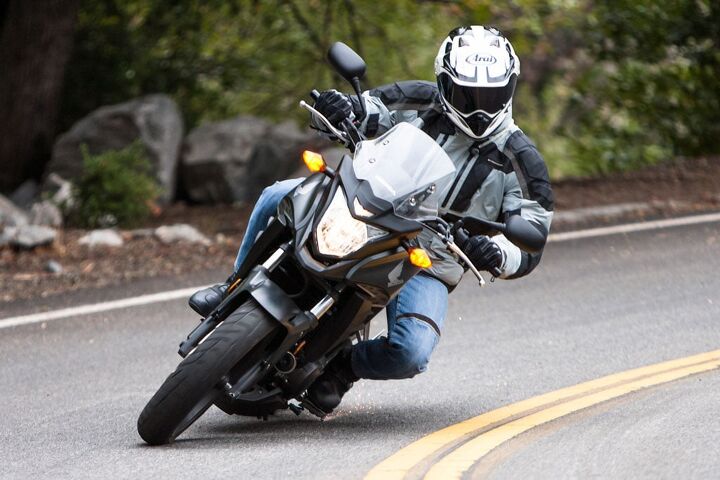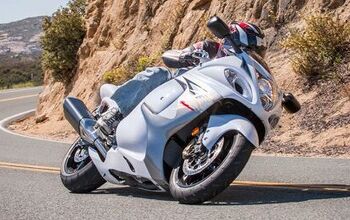Motorcycle Cornering Clearance – What To Do When It Runs Out

Strategies for safely handling corners when hard parts touch ground
Newsflash: Lean a motorcycle over far enough in a corner and something other than those black, round, sticky things we call tires is gonna touch the ground.
While sportbike riders may scoff at motorcycles with lesser ground clearance than that allowed by their proctologist’s crouch inspired riding position, all motorcycles will drag something – even some riders’ elbows – when cranked all the way over.
On the street, cruisers and some standards will run out of ground clearance at a pace attainable by mere mortals. Many experienced riders can tell stories about riding in a group with a wide range of riding experience and ability when, suddenly, a rider who’s riding a bit faster than usual scrapes a peg or floorboard and gets startled. What happens next determines whether you’ll all be laughing it up at the next stop while everyone gets to see the scuff marks on the formerly virgin peg feeler or waiting around for someone to go get a pickup to haul a bent bike and its (hopefully just embarrassed) rider home.
The anatomy of such a crash is fairly simple. The rider, startled by the sound and vibration of metal contacting pavement, instinctively stands the bike up. Often the rider will then just run the bike straight off the road because he’s caught in the horns of a powerful – if inaccurate – dilemma. His brain is telling him he can’t lean the bike over even though it is now almost completely upright.
Motorcycle Downshifting Techniques
Target fixation is the other most common cause of running off the road after being startled by touching down. Come on, every one of us has faced the all-consuming focus on that object in front of us that… we… absolutely… do… not… want… to… hit.
If we are able to recognize – in the moment – that this fear-induced brain lock is going to send us right into the object we want to avoid, then we can force our attention back to our desired path of travel.
Here is a place where racers and track riders have an advantage over street riders. While the track is, in many ways, safer than the street, the environment does give you close proximity to surprising events like a rider low-siding and sliding out away from you mid-corner. This type of sudden distraction can give you the opportunity to learn to pull your attention back to the task at hand without the additional static of oncoming traffic or large immovable objects at the edge of the pavement.
Cruisers, by virtue of their low and forward-mounted pegs and floorboards, are most susceptible to dragging. The good news is that the manufacturers have designed these bikes to contact the ground with folding parts before something solid, like the pipe or frame hits. The bottom of most pegs have some sort of protrusions termed “feelers” that provide warning that available ground clearance is running short.
All this means, that if you’re dragging flexible parts in a constant-radius corner, you could continue on the same path at the same speed – provided the pavement is smooth – with no problem. The last thing you want to do is chop the throttle or abruptly brake since you’ll immediately lose ground clearance as the weight shifts forward.
While current generation shaft-driven cruisers have minimized the shaft effect, older models would lose considerable ground clearance from rear end squat on deceleration. Softly sprung bikes will also touch down sooner over rough pavement or in high speed sweepers as the suspension compresses. (The Zero S we tested this year is a prime example of how cornering clearance can be compromised by a soft suspension.)
Proper Motorcycle Lane Positioning
Suspension compressing after going over a dip in a corner is a pretty common way to drag things, and unfortunately, the abruptness of this suspension movement makes it more likely to touch down a non-flexible part, giving the chassis a momentary jolt.
Pay special attention to forward-mounted footpegs that angle your feet so that their heels are prone to dragging. All it takes is having your boot pulled off the peg one or twice before you find yourself moving your heel to the peg prior to entering a corner.
Cruisers aren’t the only bikes that can cause you to drag your boots. Riders of standard or touring bikes can sometimes drag the sides of their boots before the pegs touch down. (There’s a reason why boot manufacturers put toe sliders on the outside of racing boots.) Riders who hook their heels on the pegs and flex their toes downward can actually cause a crash if they catch their toes hard enough.
When your bike touches down, it’s completely natural to twitch and slightly upset your bike’s chassis and line through the corner. A good way to minimize this reaction is to go out and purposely drag the pegs/floorboards. If you have access to a large, clean parking lot, go ride in circles at a moderate speed. (Do we need to remind you that you should be wearing proper gear in case of a tip over? We thought not.) Once you’re settled, try dipping the bike in for a short duration additional lean.
After you’ve found the point where the bike grounds, try extending the drag a bit further to allow yourself to become more accustomed to the sensations and sounds. Since you’re in a controlled environment, you can push it a little too far to feel how the character of the grinding becomes harsh as solidly mounted parts hit the pavement. Be careful not to go any further, or you risk levering a wheel off the ground, causing a crash.
Motorcycle Riding in the Wind and Rain
The further forward on the bike that the solid hit occurs, the bigger the risk of lifting the front wheel. Think back to your high school physics class. The front wheel and the rest of the chassis are at opposite ends of a lever with the contact point on the ground acting as the fulcrum. The part with the most weight on it (the engine) will use the fulcrum as the pivot point to raise the front wheel. Cue the sounds of shattering plastic.
So, what’s a rider to do upon discovering that the corner has a decreasing radius or that the bike is simply traveling too fast for the tightness of a curve and has begun to drag its pegs/floorboards?
You really have two choices: alter your line and/or reduce your speed. If the shape of the corner allows, widen your line for the remainder of the turn. If that is not possible, you’ll want to slow down or, at the very least, not go any faster. For experienced riders whose bikes don’t have linked brakes, the best method for slowing down is to maintain a neutral throttle while carefully applying the rear brake. This scrubs off a bit of speed without dramatically shifting the weight forward. Traction for braking is limited in a turn, so a good bit of finesse is required of this maneuver.
All riders are surprised the first time they touch down out on the road. How much you’ve prepared for the event will dramatically improve the chances of responding appropriately and having a good chuckle about it afterwards.

Like most of the best happenings in his life, Evans stumbled into his motojournalism career. While on his way to a planned life in academia, he applied for a job at a motorcycle magazine, thinking he’d get the opportunity to write some freelance articles. Instead, he was offered a full-time job in which he discovered he could actually get paid to ride other people’s motorcycles – and he’s never looked back. Over the 25 years he’s been in the motorcycle industry, Evans has written two books, 101 Sportbike Performance Projects and How to Modify Your Metric Cruiser, and has ridden just about every production motorcycle manufactured. Evans has a deep love of motorcycles and believes they are a force for good in the world.
More by Evans Brasfield







































Comments
Join the conversation
i drag my roadstar floorboards on the ground on any flat road, no corners needed. and in a good corner, it grinds right up to the frame, which has a pretty long flat spot on it. at to great a speed, i cant push the bike over enough to get a good grind. the V&H pro pipe is all scraped up too.
i did once have the rear tire 'lever' clean off the pavement in a wide left off camber sweep that stunned me when i felt it break loose ~20mph, at a traffic light intersection, with many onlookers as they heard the scrape grinding. Newtons law's had a tough time figuring out which one was going to beat me and gave up as i rode through it.
Hummm, I've dragged the sump guard on my BMW F800GS a few times, hanging off was the only cure!